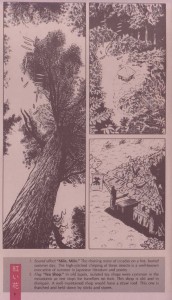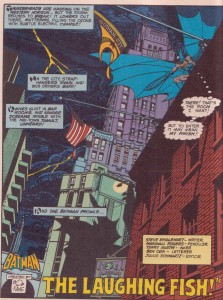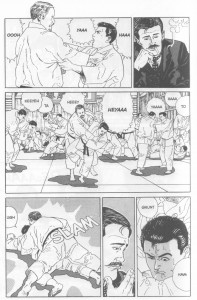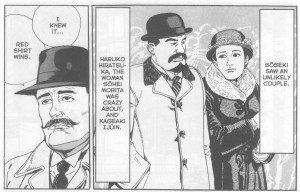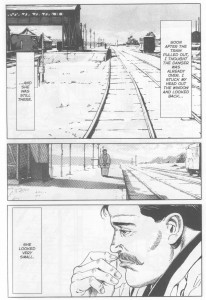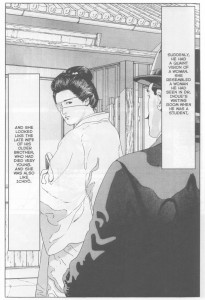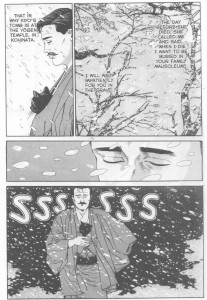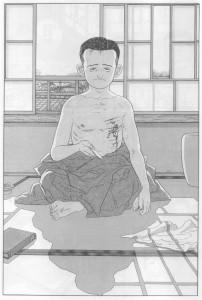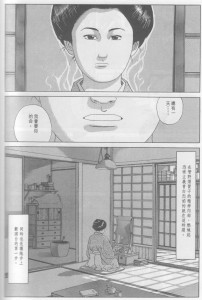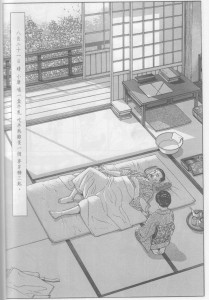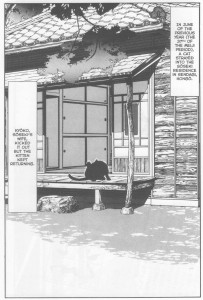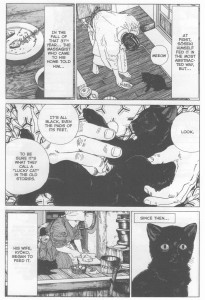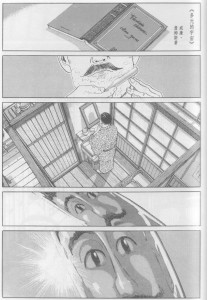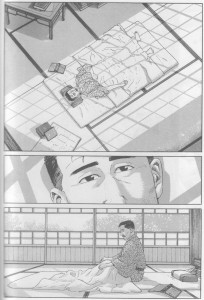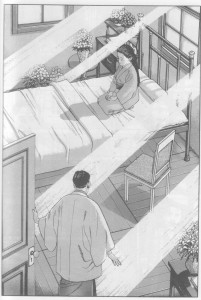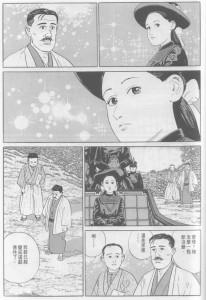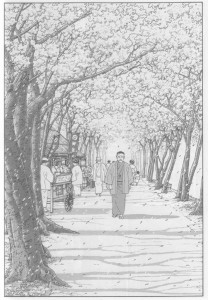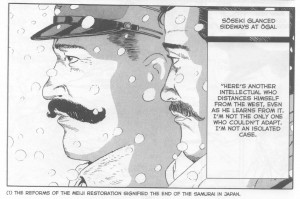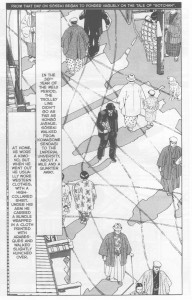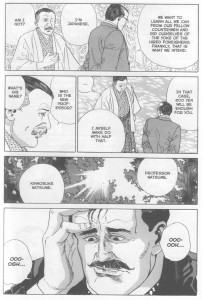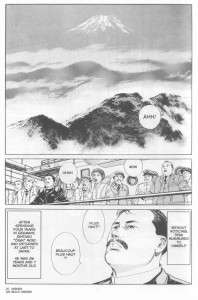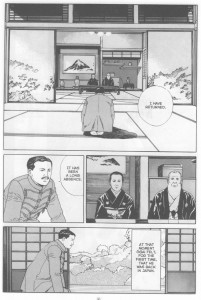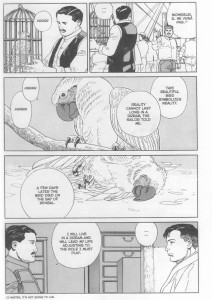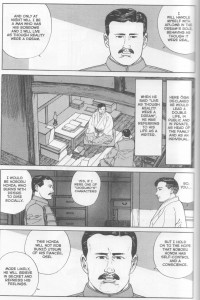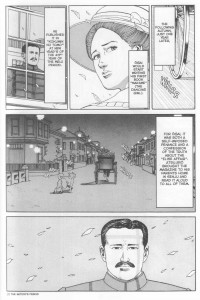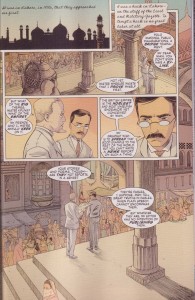Red Flowers. Sayako Kikuchi is lying in the shade of her tea shop. It is a warm summer day and far too hot to count the meager takings from the morning. There is the sound of cicadas in the background and we gaze up at this incessant activity with the girl. The tree before us is as firm and immovable as nature itself. The tea shop is cradled in its grasp, nestling in a womb-like clearing with tendrils and fruit running through its thatched roof.
Tag Archives: Reviews
Review: Josh Simmons’ House
In an interview given in conjunction with Archi et BD, la Ville Dessinée (see Alex Buchet’s post), Jean-Marc Thévenet suggests there is in many comics “a psychological pressure suffered by a hero who is more often than not dominated by the environment in which they live.” This is, perhaps, the most common manifestation of architecture in American comics.
At a more popular and utilitarian level, we have Marshall Rogers’ delineation of the ornamented skyscrapers, alleyways, fire escapes and bricks that make up the borders of Batman’s Gotham, casting the caped crusader into realistic space, Rogers’ occasionally clumsy anatomy and staging notwithstanding.
Review: The Playwright
Warning: Spoilers Throughout
The latest comic by Eddie Campbell is conventional in a number of ways peculiar to the form. It is a collaboration with a writer, in this instance Daren White, the editor of the Australian anthology DeeVee. Also familiar is the presentation which is not dissimilar to what you might find in a newspaper strip collection with the panels laid out in single file across a squat rectangular book. The pages only lack the closing punchlines once deemed so necessary to such endeavors, but these occur frequently enough so as to negate any perceived differences; the temporary conclusions and logical ellipses between the pages being the very stuff of modernity (see Campbell’s remarks on the rearrangement of the strip from 9 panels per page to its current format in the interviews below).
Review: The Times of Botchan (Part 2)
A Review of The Times of Botchan (Part 2)
[Part 1 of this review can be found here]
(3) The Times of Botchan Vol. 1 & 2
The closing pages of the fourth volume of The Times of Botchan are the high point of the first half of the manga series. It is here that the authors begin to present conversations that defy easy explanation and sequences that engender poignant contemplation. The first two volumes by comparison are unfocused and tentative, veering haphazardly from comical to more deeply intellectual episodes — as if the authors were uncertain of their audience’s ability to stick to a tale devoid of levity. Some might say that these transgressions are a function of the manga’s attempt to portray the birth of Soseki’s Botchan (which is a comic novel) but they also seem to be grappling with the immensity of the task ahead of them, as well as the ambiguous long-term future and direction of the project. There are some residual traces of this inconsistency in Volumes 3 and 4 of the series but all marks are virtually extinguished in the more focused, patient and sure-footed later volumes.
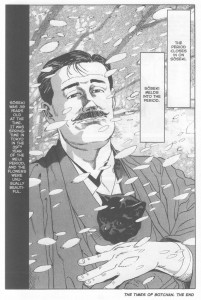
That this series is aimed at a select Japanese audience is evident very early on. While a casual Western reader might be expected to know of or even read some Soseki, it is doubtful if many would have knowledge of the poet, Ishikawa Takuboku. It is equally doubtful that this kind of knowledge would be available to the typical young Japanese manga reader. Yet Takuboku is mentioned five pages into the first volume of the book with nary an explanation and merely as a reference for Soseki’s comfortable salary.
Sekikawa’s professed intention in the first two volumes of the manga — to fashion a story about the writing of Soseki’s Botchan — is less problematic since this novel is a much more popular work, particularly in Japan. At various points in their tale, the authors insert vignettes of Meiji life to suggest sources for Soseki’s ideas in Botchan. There are references to jujitsu just as there are in the novel where a character boasts about his abilities in that martial art.
The barroom brawl in the manga is perhaps meant as a precursor to the fracas between normal- and middle-school students toward the close of the novel. These sections will mean little or nothing to a person who has never read the novel. No such knowledge is required to appreciate the narratives of Volumes 3 and 4 of the series, which concern Ogai and Futabatei.
An uninformed reader perusing the manga in isolation could be forgiven for thinking that Botchan was a novel specifically about the modernization of Japan and the clash between Eastern and Western mores during the turbulent years of the Meiji era. In fact, it is, superficially at least, a somewhat gentle if satirical story of provincial life and its idiosyncrasies. Narrated by the eponymous hero, Botchan begins life as a self-proclaimed “great loser” who has done many “naughty things.” He is neglected both by his father and elder brother and is cared for, from the period of his mother’s death, by a kindly servant called, Kiyo.
As a young adult, he earns a college degree and accepts a teaching job far away from his native Tokyo in a provincial school. In a series of amusing encounters with his students, fellow teachers, hotel staff and landlord, he finds them almost without exception (at least initially) repulsive, giving them nicknames like Badger, Green Squash, Porcupine and Red-shirt (the “villain” of the story). Far from simple yokels, many turn out to be tasteless, backbiting, sexually unrestrained barbarians, even in comparison to his own brash and impulsive self.
At the start of Chapter 11 of the manga, the authors provide us with a letter from Soseki to his editor, which reads, “Many things in the way the young men around me act have inspired me so the subject keeps on growing.” The young men we see around Soseki at the start of the manga are substitutes for the kind of men Soseki might have met during the writing of Botchan. Translator Umeji Sasaki attempts to point us in the right direction in his foreword to the novel:
“Old Japan with her polite, yet often deceptive, ways is passing to return no more, and New Japan with her honest, simple, frank democratic ways must come to speak and act in world terms. Botchan … is in many respects a young man embodying the new ideals of New Japan.”
Writing in 1922, Umeji does not question the desirability of the new ideals, nor is it entirely clear from our present-day perspective if the Old Japan he specifies has in fact passed away.
In the novel, the repulsive aspects of the New Japan are embodied in the character of Madonna, who was at one point engaged to Green Squash. As a consequence of some financial reversals suffered by her fiance, she has since drifted towards the villain of the piece, Red-shirt. This scenario is played out in the manga with real life individuals taking the place of literary ones. When Soseki sees the feminist writer and activist, Raicho Hiratsuka (a historical person) abandon one of his young friends for another of greater prestige, he can only say, “I knew it, Red-shirt wins”.
The authors close the first volume of The Times of Botchan with the image of Kiyo standing at the train station as she sees Botchan off to his new job. As Sekikawa explains, she “belonged to the previous era and symbolized spiritual peace and Soseki’s dream woman.” Soseki’s feelings as to this personification of a better time is apparent when Sekikawa reproduces the final sentences of the first chapter of Botchan in the manga:
“The locomotive began to move with its usual puff, puff. Thinking it quite safe now, I looked out of the window and turned to the spot where she had been standing. There she still stood, looking after me with a longing eye. She appeared so very small.”
Soseki’s vision of Kiyo toward the close of the second volume is that of a motherly woman with a patch over her right eye — a metaphor that doesn’t require much explanation.
At the end of the novel, Botchan and Green Squash catch Red-shirt and his lackey Noda red-handed following a sexual escapade with some geisha. They beat them up but finally return to Tokyo where Botchan sets up house with his old servant (and surrogate mother), Kiyo. She dies soon after and asks to be buried in Botchan’s family graveyard. The second volume of the manga closes with Soseki gazing into his garden as Sekikawa’s narration melds subtly into commentary:
“Botchan had a place he could go home to. The house where Kiyo lived, that is, a place where an old fashioned spirit reigned.”
It should be stressed, however, that the authors never suggest that the values of Kiyo are inherently superior to those of Madonna — the Soseki of the manga is always sympathetic but he is not always right.
***
In his capsule review of the first two volumes, Chris Mautner suggests, quite rightly, that The Times of Botchan is “a book where your enjoyment is in direct proportion to your familiarity with the subject matter.” He offers this comment without criticism, but I would suggest that this is not only a failing but one that originates from inexperienced writing rather than any large deficit in the reader. In short, the first two volumes lack a certain universality born of a cluttered narrative and an everything-but-the-kitchen-sink approach — in particular the endless parade of peripheral historical personages who distract rather than enrich or engage. It is clear that many of the early sections of the book read too much like a textbook.
As it is, The Times of Botchan contains a procession of coincidences where the lives of historical characters somehow intersect in the same way that Kenneth Toomey seems to know every important personage of his time in Burgess’ Earthly Powers. For example, in the first volume, Soseki bumps into both Hideki Tojo and the man who would one day assassinate Hirobumi Ito (the first Prime Minister of Japan), Jung-Geun An. In the third volume, Futabatei encounters not only Elise Weigert, but also the feminist writer, Ichiyo Higuchi, (who currently appears on the 5000-yen note) all in the course of a single day. The latter meeting results in Futabatei’s adoption of Higuchi’s dog, which continues to pop up in the course of the entire series — sometimes as a passive observer and, at other times, simply hounding Soseki.
This is, of course, a perennial problem facing adaptors who try to shape and distill a basic structure from the denser whole of a novel or age. A similar dilemma faced the screenwriters for Luchino Visconti’s The Leopard when they attempted to explain the significance and flow of events during the Risorgimento to a modern Italian audience. A comparable situation can be found in Hiroshi Teshigahara’s Rikyu, a viewing of which can only be enhanced by a working knowledge of Warring States period Japan, though this information is never a prerequisite for one’s enjoyment of the film.
In the same vein, while certain readers may find the “simplicity” of Soseki’s writing style (as cultivated by his knowledge of classical Chinese literature and poetry) somewhat distancing, any inability to appreciate his works cannot be adequately blamed on cultural ignorance so much as a failure to perceive the complex undercurrents and structural intricacies which he is so skillful at hiding. One can read Botchan without once suspecting many of its underlying themes — the characters never become mere symbols. As Damien Flanagan in his introduction to Soseki’s The Gate writes:
“What is remarkable about the novel — indeed about all Soseki’s later novels — is that, although the structure of the novel is ultimately profoundly ironic, the portrayal of the characters is so sympathetic and realistic that this overarching scheme to complex ideas becomes almost invisible.”
The first two volumes of The Times of Botchan would have been much finer and more coherent works had they been pared down to the essential aspects of the genesis of Soseki’s novel. Thankfully, readers will find that these problems recede quite swiftly with later volumes in the series, which bring on a fine maturing in both art and writing. The third and fourth volumes of the manga rarely betray the fine network of references and metaphors that lie over the series like a tapestry.
(4) The Times of Botchan Vol. 5-10
The forthcoming volumes of The Times of Botchan are biographies of other famous men and women who have responded to the changes of the Meiji era.
The fifth and sixth volumes tell the story Takuboku Ishikawa (1886-1912), a master of tanka, from his earliest days to his life as a newspaper editor. This section closes with some of the more startling episodes from his Romaji Diary (kept from April 7 to June 16 1909), which was never published during his lifetime. The most disquieting of these is the moment where he describes a misogynistic dalliance with an 18-year-old prostitute, in which he puts his fingers into the woman’s vagina and “roughly [churns] around inside” only to find that the sleeping woman only responds with pleasure when he begins to fist her. A month or so later he is cutting himself on the chest with a razor as a pretext for staying away from work. The manga describes the struggles and sheer dreariness of a poverty-stricken literary existence. His life, as vividly described in Romaji Diary, is often so filled with depression, bitterness and pain that it engenders a certain sympathy from the reader. The sixth volume ends with the same scene that closes Romaji Diary: the arrival of Takuboku’s mother and his wife, Setsuko, in Tokyo. (They had been living under the care of his friend in Hakodate up to that time because of his inability to support them.) This is not the happy circumstance one might expect. As Sandford Goldstein and Seishi Shinoda write in their introduction to their translation, “that key moment in Takuboku’s life was to prove a kind of breaking point. Several tanka in Sad Toys … the collection of poems written in the last year and a half of his life, record the conflict between Setsuko and Takuboku’s mother.”
The seventh and eighth volumes of the manga are the most overtly political of the entire series. They recount the lives of Shusui Kotoku (1871-1911) and Suga Kanno (1881-1911), whose response to the changing times was anarchy and rebellion. Together with nine others, both were executed after a trial for their parts in the Kotoku Incident (or High Treason Incident) which Goldstein and Shinoda call “the most revealing example of despotism during the Meiji era.” The detail with which their lives are brought to the attention of the reader bears comparison with the works of Jack Jackson and Chester Brown’s Louis Riel. Perhaps symbolically, Soseki begins to develop a more severe gastric problem in the closing pages of these two volumes. By the end of Vol. 10, Takuboku is writing about the death sentence of the anarchists involved in the Kotoku incident and experiencing the first signs of the peritoneal tuberculosis that will kill him in 1912.
Both volumes nine and ten take in the closing years of Soseki’s life beginning with his sojourn at Shuzenji hot springs in 1910 to his coma and near-death experience following a massive hematemesis.
He is nursed by his estranged wife, Kyoko, who remains faceless throughout the narration as if in silent commentary on the hostility she has received from some students of Soseki. Soseki gives a kinder and much more complex portrayal of his wife in Grass on the Wayside. These volumes also record his vehement refusal of an honorary doctorate from the Japanese government on ethical grounds.
Making periodic appearances throughout the entire series, including its conclusion (if only spiritually) is a black cat. At the most basic level, this cat is the physical manifestation of Soseki’s inspiration for his first novel, I Am a Cat. Early in the novel, a massagist visits Soseki’s home and identifies it as a “lucky cat.”
More than this and as explained in the introduction to the Tuttle edition of I Am a Cat, Soseki was himself a kind of “stray kitten.” It has been suggested that both financial considerations and the advanced age of his parents at the time of his birth made him a source of embarrassment. As a result, he was placed in the care of a foster family till the age of 9 before rejoining his parents again upon the divorce of his adoptive parents. The cat thus represents both Soseki’s inner voice (at times playful, at other times serious and combative) as well as the vanishing times.
Of particular note in Vol. 10 is the 100-page discourse in the realm of dreams which begins in the chapter titled, “What are you doing here, Teacher?”
[Read from right to left]
The initial moments of this dream are presented as a plausible reality, with Soseki attending to his morning toilet and meeting up with Takuboku. They discuss his present financial circumstances — a pet topic of both writers — and the progress he has made in his poetry. In the hotel restaurant, he encounters an older Ogai as he meets up with Elise many years after the events that inspired “Maihime”. Then, while employing various means of transportation, he meets his old teachers, political figures and the women who have enriched his days and writings in a grand summation of his life, his art, the times he has lived in and the manga series.
Readers familiar with Soseki’s novel Sanshiro (1908) will recognize this device; specifically a dream narrated by Professor Hirota toward the close of the novel where he encounters “a pretty young thing maybe 12 or 13.”. What follows in the manga is a partial transcription of this dream sequence with Soseki taking the place of Hirota. From the novel:
“Then I asked her, ‘Why haven’t you changed?’ and she said, ‘Because the year I had this face, the month I wore these clothes, and the day I had my hair like this is my favorite time of all.’ ‘What time is that?’ I asked her. ‘The day we met twenty years ago,’ she said. I wondered to myself, ‘Then why have I changed like this?’ and she told me, ‘Because you wanted to go on changing, moving toward something more beautiful.’ Then I said to her, ‘You are a painting,’ and she said, ‘You are a poem.'”
That day twenty years ago was the date of the funeral procession of Minister of Education, Arinori Mori (in 1889), where Hirota first caught a glimpse of the girl in her carriage. In his translation of Sanshiro, Jay Rubin indicates that “Soseki’s use of a public incident like the assassination…would seem to indicate that as he undertook to write the novel, he was thinking about a time in his life when he himself experienced a major disillusionment”. The girl in the manga differs from the girl in Sanshiro by the lack of a mole on her face, and the insertion of this sequence may hint at the authors’ intention to highlight Jun Eto’s thesis that Soseki had an affair with his sister-in-law, Tose, sometime around 1890.
It is also clear that they mean to suggest that Soseki the writer will “go on changing” as his works are interpreted and reinterpreted over the years, remaining as eternal as the cat, once thought dead, who appears alive again at the series’ close. The Times of Botchan is full of instances like these and more: there are incidental points hiding references and meaning; sociopolitical and literary analysis; vivid imaginings of long lost lives; and moments of ethereal beauty and mystery. There can be little doubt that it is one of the finest historical manga available to the comics reader today.
END
Review: The Times of Botchan (Part 1)
I’ve decided to reprint an old review of The Times of Botchan to tie in with the recent release of the fourth volume in the series. The article was written about two years ago and was first published in truncated form in The Comics Journal. Those seeking further guidance on whether or not to buy these books should read the reviews I’ve listed below.
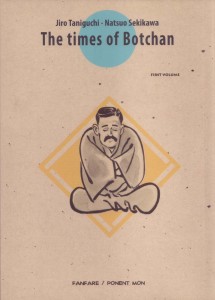
The central figure which unites the 10 volumes (five volumes in Japan and Asia) that make up The Times of Botchan is Natsume Soseki, one of Japan’s greatest writers. The series may be viewed as a history of the closing years of the Meiji era, a biography of various literary and political figures which emerged during those times, and a meditation on the impact of that period on the Japanese psyche.
The series as a whole was awarded the Osamu Tezuka Culture Awards Grand Prize in 1998.
Further reading:
Katherine Dacey’s review (2010). I am inclined to agree with many of the faults enumerated by Dacey, in particular the unwieldy writing and the uneven quality of the first two volumes.
Joey Manley on the first volume and translation issues (from 2006). A somewhat messy rant but he brings up valid issues concerning the distancing elements in the narrative. He also takes down Leo Tolstoy and Boris Pasternak at one point.
Derik Badman’s review (2006) of Volumes 1 and 2. Badman is a much more patient reader than Manley. He describes the general tone of these books and provides a nice summary of the various plot points.
Matthias Wivel’s review (2003) of the earlier volumes in the series (in Danish).
***
A Review of The Times of Botchan (Part 1)
by Jiro Taniguchi and Natsuo Sekikawa
Toptron Ltd. /Fanfare (B&W, Softcover)
Vol. 1: 144 pp., $19.99 ISBN: 9788496427013
Vol. 2: 128 pp., $19.99, ISBN: 9788496427099
Vol. 3: 156 pp., $19.99, ISBN: 9788496427129
Vol. 4: 144 pp., $19.99 ISBN: 9788496427136
(1) Introduction
The Times of Botchan is a historical manga concerning the end of the Meiji era in Japan. The manga begins in the early twentieth century and uses as its fulcrum and lens, the life of Natsume Soseki.
The heart of the series is neatly stated in the second chapter of the first volume and bears putting down in whole:
“The roots of Soseki’s illness were the same as those of the malaise of the Japanese who had awoken for the first time to consciousness about their own national identity within a modern social order and of the dilemma faced by the intellectuals, who had no choice but to learn from the West even though they hated it.”
Natsume Soseki (pen-name of Natsume Kinnosuke; 1867-1916) is generally recognized as Japan’s foremost modern novelist. In the manga and to a certain extent even in present day Japan, he is the embodiment and voice of the spiritual conflicts that emerged during the Meiji period.
During his lifetime, Soseki was one of the most respected authorities on English literature in Japan. He brought the modern Japanese novel to fruition through his study of Austen, Dickens, Sterne and Swift. Yet, as the introduction to Aiko Ito and Graeme Wilson’s translation of I Am a Cat indicates, he appears to have been largely unimpressed by Western enlightenment; “throughout his career, he remained essentially and uncompromisingly Japanese.” His two years in London were wretched and his views of the English twisted by anemic social contacts. In My Individualism, Soseki writes, “To tell the truth, I do not like England very much, but in spite of this, I must allow it one thing, reluctantly: probably, in no other part of the world, are the people both as free and as policed.”
As is made clear by authors of the manga, this ambivalence was not solely restricted to Soseki. The third and fourth volumes of The Times of Botchan are essentially about the other great literary voice of the Meiji era, Mori Ogai (1862 — 1922). In his story, we find a conflict between the individuality so prized by the West and the sense of duty and honor that was fast being encroached upon in Japanese life during that period.
These volumes also take in the intertwining life of Shimei Futabatei (1864 — 1909), the author of what has been described as Japan’s first, albeit incomplete, modern novel, Ukigumo (The Drifting Cloud). His other great distinction was as a translator of Turgenev. In her commentary on Ukigumo, Marleigh Ryan quotes Futabatei as he reflects on his formative years:
“I had as my ideal in those days the word “honesty.” I wanted to live a life free of shame before Heaven or man. This concept of honesty had been nurtured in me by Russian literature, but an even greater influence was the Confucian education I had received. … The oriental Confucian influence and the Russian literary or Western philosophic influence became bound up together. To these were added an interest in socialism. From these various influences my moral philosophy was formed.”
This statement stands in contrast to Futabatei’s views on unbridled Westernization. In the opening pages of Ukigumo, for example, he describes a thoroughly frivolous and spoilt girl called, Osei, who is under the tutelage of the “loathsome” headmistress of a finishing school:
“Things went from bad to worse after she started studying English at school. She switched from a Japanese under-robe to an undershirt and adopted a Western style hairdo, strangled herself with a scarf and donned eyeglasses which ruined her perfect vision. Her self-approved transformation was perfectly ridiculous.”
In the first volume of the manga, Sekikawa and Taniguchi provide us with some instances of this tension between tradition and modernization. Soseki is first seen potting around his house in a traditional Japanese housecoat and then clothed in Western dress as he navigates the streets of Tokyo. At one point, he is found formulating a scene for his novel Botchan in which the protagonist both physically and intellectually humiliates a European. He then suffers a bout of crippling dyspepsia when he discovers that his job as a lecturer in Tokyo Imperial University has been acquired at the expense of a noble foreigner (the irony here being that Soseki is destined to die of a stomach hemorrhage in 14 years time).
The foreigner in question was Lafcadio Hearn, the Irish-Greek writer and translator who became a naturalized Japanese citizen. He is best known in the West through Masaki Kobayashi’s film, Kwaidan, which is an adaptation of four supernatural tales from his collection of the same name. Of Hearn, Roger Pulvers in an article for The Japan Times writes:
“Even today, Hearn is considered in this country the foreigner who understood the Japanese in the most profound way. … Name a field of study of traditional art or life and Lafcadio Hearn was intrigued by it, swept away by it. He is the founding father of the school of Japanese uniqueness, the fountain that provides the spiritual and aesthetic nourishment … that Japanese people require to convince themselves that they are more than the sum of their borrowed and mechanically transformed parts.”
But Hearn was interested in the “Old” Japan, one which officials (including those at his university) were eager to put aside. This realization would come to haunt him in his later years and Pulvers quotes him as writing, “I felt as never before how utterly dead Old Japan is and how ugly New Japan is becoming. I thought, how useless to write about things which have ceased to exist.” Hearn died in 1904. Eight years later, the death of the Meiji Emperor would prompt what was perhaps the most famous act in response to this sense of passage and change.
In 1912, shortly after the death of the emperor, General Nogi Maresuke committed seppuku, ostensibly in expiation for his military mistakes and specifically for having lost his regimental banner in Kyushu during the Satsuma rebellion over 30 years earlier. His death would leave its mark on the writings of both Soseki and Mori Ogai. In Soseki’s most influential work, Kokoro, we find what may be his own thoughts in the words of one of the protagonists called, Sensei:
“I felt as though the spirit of the Meiji era had begun with the Emperor, and had ended with him. I was overcome with the feeling that I and the others, who had been brought up in that era, were now left behind to live as anachronisms.”
In his introduction to the novel, Edwin McClellan writes that, “Soseki was too modern in his outlook to be fully in sympathy with the general; and so is Sensei … however, he could not help feeling that he was in some way a part of the world that had produced General Nogi”.
(2) The Times of Botchan Vol. 3 & 4
Nogi’s death had an even greater impact on Mori Ogai, and it is this sense of nobility and responsibility that informs the third and fourth volumes of The Times of Botchan (even if the events depicted within occur a number of years before the death of the general).
At the start of these interconnected volumes, it is 1909 and Shimei Futabatei is dead. In five years, the Meiji emperor will also have passed on and, in seven, Soseki will collapse from a stomach hemorrhage. Futabatei’s funeral is attended by some of the most famous writers and thinkers of the time, among them Soseki, Ogai and Ishikawa Takuboku, the three writers whose lives are most developed upon in these series of manga.
As with the first two volumes, this section of The Times of Botchan is also about the creation of literature. The cover description tells us that the book focuses on the relationship between Ogai and Elise Weigert, the inspiration for Ogai’s story, “Maihime” (“The Dancing Girl”), but it is also the story of Futabatei and Ukigumo.
“Maihime” was written in 1890 and has been noted for bringing “a new dimension to the literary expression of personal emotions in Japanese literature.” The story is narrated by the protagonist, Toyotaro Ota, who is the top student in his university and a civil servant of three years. He is sent to Germany to “study matters connected with [his] particular section.” At first he finds himself reading law but soon turns to the arts and history, much to the displeasure of his superiors. The opening pages of the story allow us to look deep into his soul. From Richard Bowring’s translation:
“Some three years passed. … I had studied willingly. … But all that time I had been a mere passive, mechanical being with no real awareness of myself. … I realized that I would be happy neither as a high-flying politician nor as a lawyer. … I felt like the leaves of the silk-tree which shrink and shy away when they are touched. … Ever since my youth I had followed the advice of my elders and kept to the path of learning and obedience. If I had succeeded, it was not through being courageous.”
Toyotaro’s first meeting with Elise differs little from Ogai’s own encounter in the manga. She is a dancer whose father has just died. As she is penniless, she has asked for aid with the funeral expenses from her employer who has sought to take advantage of her. Toyotaro promises to help her and produces his watch for her to pawn. Their feelings for each other deepen and soon turn to those of love. His superior is irked by his diversions and tells his “legation to abolish [his] post and terminate [his] employment.”
Toyotaro improves himself through journalistic activities and soon becomes a skilled translator. The arrival of a prominent Japanese minister in Berlin leads to an opportunity to redeem himself but he is urged “to give her up” by a friend and assistant to the minister called, Aizawa. Upon hearing this advice, Toyotaro is struck by severe misgivings: “When he mapped out my future like this. I felt like a man adrift who spies a mountain in the distance. But the mountain was still covered in cloud …”
This passage from “Maihime” may be compared with Sekikawa and Taniguchi’s depiction of Ogai’s vision of Mount Fuji early in Vol. 3. To be precise, there are two visions of note at the start of the third volume. The first is that of Elise Weigert, the German dancer who Ogai has promised to marry following his four years of study in Germany — a symbol for Western self-sufficiency and exuberance. The second (the one that applies here) is that of Mount Fuji, a symbol for Japan, first glimpsed upon Ogai’s return from Germany in 1888.
Upon the exhortation of the ship’s captain to look “higher, look much higher up,” Ogai does so only to see the peak of Mount Fuji appearing through the clouds. This image of Fuji is repeated again in a brush painting that hangs behinds his emotionless parents during his first audience with them since his return. To emphasize his point, Sekikawa narrates:
“At that moment Ogai felt for the first time, that he was back in Japan. In the country, individualism was not regarded as a personal virtue, the “family” had to be considered.”
Toward the close of “Maihime,” Elise becomes ill and discovers that she is pregnant just as Toyotaro is asked to travel to Russia to work as an interpreter. His duties “suddenly [lift him] from the mundane and [drop him] above the clouds into the Russian court.” Elise writes a loving and beseeching letter to Toyotaro and he encounters yet another crisis of confidence amidst his own joy:
“Was my passion cooling? … I thought I had discovered my true nature, and I swore never to be used as a machine again. But perhaps it was merely the pride of a bird that had been given momentary freedom to flap its wings and yet still had its legs bound. There was no way I could loose the bonds. The rope had first been in the hands of my department head, and now, alas it was in the hands of the count.”
Toyotaro, wracked with guilt, falls ill, and Elise learns of his betrayal indirectly from Aizawa even as she nurses him. She goes mad and becomes a “living corpse.” At the end of the story, Toyotaro leaves for Japan with the minister, leaving behind some money to pay for the birth of his child.
There are other links between Ogai and his protagonist not mentioned above: as with the story, the real Elise only learns of Ogai’s betrayal indirectly through his friends; the ornithological metaphor that Toyotaro uses in “Maihime” correlates with Ogai’s use of a captive bird to describe the conflict between dreams and reality in the manga. These connections are weaved into a tangle of fictions juxtaposed for effect. There are also some significant differences between Ogai’s experiences as depicted in the manga and the prose story: the Elise of the manga never becomes pregnant and her exact fate remains unknown.
By way of short interludes interspersed between this story, we see the birth of Futabatei’s novel, Ukigumo, and the difficulties that caused its curtailment. Futabatei would later be the first to translate “Maihime” into Russian but in these early days of struggle, we see Futabatei hard at work on the upper level of a storehouse behind his father’s house. His mother, who considers his novels nothing more than storybooks, makes disparaging remarks about his chosen vocation. Ogai compares Futabatei’s mother to the calculating, shrew like aunt in Ukigumo, but Futabatei is more understanding.
Sekikawa and Taniguchi are engaged in the recreation of the world in which this famous literary work was created. On the streets of Tokyo, we see the dispossessed members of the samurai class who are the main characters of Ukigumo. As Marleigh Ryan informs us:
“By 1868 samurai were often reduced to extreme poverty. … Whether rich or poor, however, in theory at least they shared a common ethical and moral code. This has as its basic tenets a belief in loyalty to one’s family and superiors … devotion to propriety and restraint in social behavior.”
Ukigumo has as its central character a man by the name of Bunzo who lives with his aunt Omasa and cousin Osei. As related by Futabatei, “[Bunzo’s] father had served in the old feudal government receiving a stipend under it.” This feudal order had collapsed with the establishment of the Meiji era. At the beginning of the novel, Bunzo loses his job. He has also fallen in love with Osei, but his current situation puts an end to any dreams he may have had of an early marriage. He watches on helplessly as his smooth-talking, sycophantic colleague Noboru, who is also of samurai stock, inserts himself into the household with the blessings of his aunt and proceeds to seduce Osei. Of Bunzo, Ryan writes, “His are the traditional Confucian values. … It is impossible for him to yield to the fashions of his time, and, as a consequence, he is crushed by the age.”
The events of Ukigumo become a topic in Ogai’s long conversation with Futabatei toward the close of Vol. 4 in which he establishes why he cannot marry Elise. In his opinion, a life without restraints or respect for authority will leave the Japanese, in times to come, with a bitter aftertaste. In so concluding, he compares himself to Noburo who “burns with desire to rise socially” but “[holds] on to the hope that Noboru Honda has self-control and a conscience” and “will not rob Bunzo Utsumi of his fiancee Osei.” Ogai does not identify with Bunzo’s inaction and indecisiveness (the real Ogai labeled Bunzo both “anemic” and “neurotic” in an essay written many years later); rather, he has sympathy with his values and sadness.
As with “Maihime” and Ukigumo, the manga reflects the triumph, hollow as it may seem to some, of giri (duty) over ninjo (emotion). By the time Elise and Ogai meet at the manga’s conclusion, their decisions have already been determined by force of circumstance. She has already booked a ticket on a steamer leaving Japan and he has already rejected the possibility of love. In Vol. 4, we see Elise’s presumably fictional adventures with a pair of lovers and assorted underworld characters. The lengths to which the young man is willing to go to free his lover from a life of sexual slavery is clearly to be contrasted with Ogai’s Old World hesitancy and reserve. Elise compares Ogai unfavorably to the uninhibited, self-sacrificing lovers she has been helping. Her experiences have shown her a Japan capable of forceful and spontaneous passions, but he can speak only of his obligations to the greater entities of family and country.
In the final pages of the fourth volume, Elise says that she can accept his reasons for abandoning her but not his lack of honesty with his emotions. In the manga, Ogai has no real answer for this. “Maihime,” on the other hand, contains a damning self-description by Toyotaro:
“If I did not take this chance, I might lose not only my homeland but also the very means by which I might retrieve my good name. I was suddenly struck by the thought that I might die in this sea of humanity, in this vast European capital. I showed my lack of moral fiber and agreed to go. It was shameless.”
Sekikawa and Taniguchi provide no hints as to which character has made the superior choice, for their struggle is merely a reflection of the conversations and debates that began in the Meiji era and preoccupy Japan to a lesser extent today.
Shimei Futabatei died in May 1909. On July 1, 1909, Ogai’s book Vita Sexualis (a thinly veiled account, in part, of his own sexual life) would be published in the literary magazine, Subaru. The issue would be banned by the authorities on July 28 and Ogai officially reprimanded by the vice-minister of war in August. Ogai and Elise’s conversation in The Times of Botchan is a counterpoint to that more fervent text, a marker on the road to the creation of a famous story and a literary master.
(Continued in Part 2 tomorrow)
Review: Dan Clowes’ Wilson
Synopsis with significant spoilers. “Wilson is a big-hearted slob, a lonesome bachelor, a devoted father and husband, an idiot, a sociopath, a delusional blowhard, a delicate flower.” His misanthropic existence is filled with misdirected rage and a search for meaning and connection. His closest companion is his pet dog, Pepper, but his father’s death prompts him to leave her in a quest to find his ex-wife, Pippi, and his daughter, Claire. He finds them both with the aid of a private investigator but this fleeting happiness ends when he is imprisoned for kidnapping his daughter. When he is finally released after a period of 6 years, he discovers that his dog has died. His ex-wife is already dead by her own hand. His one time dog-sitter, Shelley, becomes his only consistent companion. Wilson is briefly reunited with his daughter and discovers that he has a grandson. The connection is short-lived and she will only communicate with him through the distance afforded by an internet connection. The closing page shows him at an uncertain rest while contemplating the fall of raindrops on his window.
Review: The Unwritten #5
“All one can say is that that, while civilization remains such that one needs distraction from time to time, “light” literature has its appointed place; also that there is such a thing as sheer skill, or native grace, which may have more survival value than erudition or intellectual power.”
“Good Bad Books” (1945), George Orwell
George Orwell could be pretty cynical as a reviewer but he wrote the lines above with little of that attitude in evidence. His point is somewhat muted by the fact that most of the books he cites (anyone read Max Carrados or Dr. Nikola recently?) have long since faded from memory but we can still see a germ of truth in his essay and this statement.
Some years ago, Kim Thompson approached the entire issue from a more commercial perspective in his essay titled, “More crap is what we need”. The pithy title just about says it all. The article concerns the need for a critical mass of airy but entertaining material to sustain more rarefied and elevated pieces.
Very few would suggest that Mike Carey and Peter Gross’ The Unwritten is possessed of “sheer skill” or “native grace” but one might describe it as a light work with its “appointed place”. Whatever my feelings about the comic, it should be said that it admirably fills the niche sanctioned by Thompson in all his papal authority. While I generally have little time for comics which read like pitches to Hollywood executives, I do recognize their place within that formula which is used to monetize comic franchises. I can easily picture The Unwritten as a Hallmark mini-series – the “high” concept and sly winks at popular culture and general literary knowledge being indispensable selling points in this regard. It is a work which doesn’t so much challenge as lull. Even less can be said of its emotional heft.

